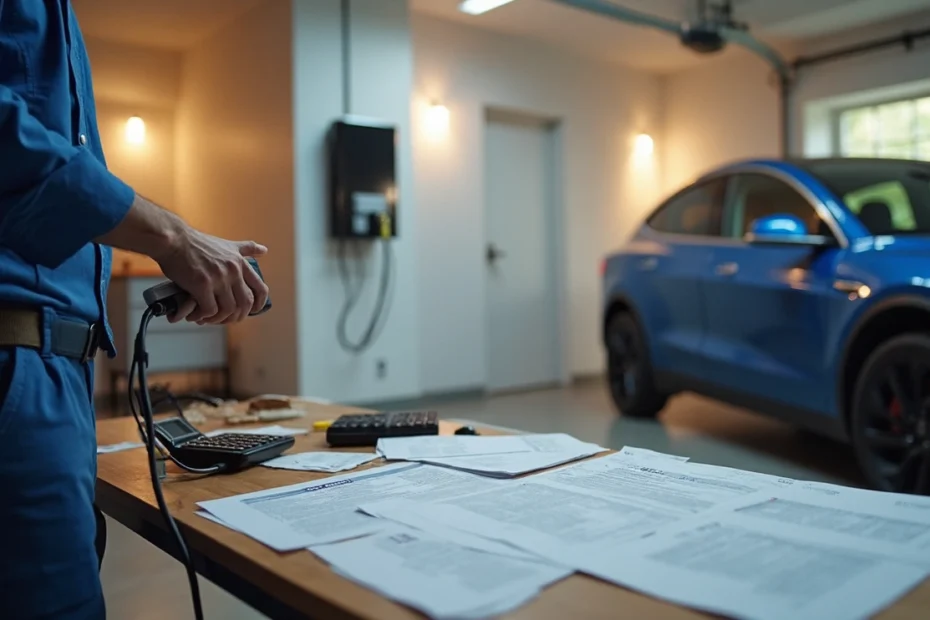Did you know the home EV charger tax credit could save you up to $1,000 on your taxes? Many EV owners know about vehicle purchase incentives, but the federal tax credit for installing an EV charger remains largely unknown.
The Inflation Reduction Act offers a vital federal EV charger tax credit that covers 30% of your total costs, including both equipment and installation, up to $1,000. Most installers won’t tell you that not everyone can get this credit. You must live in a rural or low-income area to qualify for the EV charger tax credit in 2024. This is a big deal as it means that your installation costs might reach $3,000 for complex setups—you could get back the full $1,000 when tax season arrives.
Most homeowners don’t learn about these limitations until after they’ve made their purchase decisions. This piece will reveal everything about the federal tax credit for installing an EV charger. You’ll learn about qualification requirements, needed documentation, and the vital details that installers often skip when talking to potential customers.
What the federal EV charger tax credit covers
Homeowners can get great financial benefits from the federal EV charger tax credit. Let’s get into what this credit covers.
Charger hardware and installation labor
The tax credit helps with both equipment purchases and professional installation of your home EV charger. The credit covers 30% of the costs for the charging port and all components directly connected to its operation. The labor costs for construction and installation qualify too.
Here’s a practical example: A charger that costs $1,500 (including labor) plus $500 for a wall mount designed to support the charging port qualifies for the credit. The credit also applies to additional electrical work like installing a new panel ($1,000) and the conduit/wiring needed for the charger.
Energy storage and essential components
The tax credit goes beyond just the charger and includes energy storage systems connected to your home EV charger. This helps homeowners who want to optimize their electricity usage or need backup power.
The credit covers all “functionally interdependent” components:
- The charging port (the main qualifying item)
- Supporting hardware like pedestals and wall mounts
- Essential electrical components (panels, conduits, wiring)
- Smart charge management systems
Maximum credit limits and percentage breakdown
You can claim 30% of your total qualifying expenses as a federal tax credit, with specific limits in place. For home installations at your primary residence, the maximum credit is capped at $1,000 per charging port. Each charging port that can charge at full electrical output simultaneously has its limit.
Business installations come with better benefits—up to $100,000 per charging port if you meet specific labor requirements. The business credit used to be capped at $30,000 per location instead of per charger.
The credit applies to installations completed between January 1, 2023, and December 31, 2032. You need sufficient tax liability to claim the full benefit since this credit isn’t refundable.
Who qualifies for the EV charger installation tax credit

The home EV charger tax credit might look simple at first glance, but not everyone can get it. Many installers don’t tell you about the limits from where you live, what kind of property you own, and your tax situation.
Understanding eligible census tracts
Your home’s location is the biggest factor that decides if you qualify. Since January 2023, your property needs to be in an eligible census tract. These areas fall into two groups:
- Low-income community census tracts (defined under the New Markets Tax Credit program)
- Non-urban census tracts (designated by Treasury/IRS guidance)
The good news is you need to meet just one of these location rules to qualify. While this might sound restrictive, two-thirds of Americans live in areas that qualify. You’ll need to check your eligibility this way:
- If installing before January 1, 2025: Look up your property on the 2015 Census Tract Identifier and see if your 11-digit GEOID is listed in Appendix A
- If installing after January 1, 2025: Check the 2020 Census Tract Identifier and look in Appendix B
The Department of Energy has made this easier with its 30C Tax Credit Eligibility Locator tool.
Primary residence requirement
The charger must go in your main home. You can’t get the credit for vacation homes or rental properties. The installation has to happen in the same tax year you want the credit.
Income and AMT considerations
Unlike EV purchase credits that have strict income limits, this charger credit doesn’t cap your income. All the same, you need enough federal tax liability because it’s non-refundable.
People with low tax liability or those who pay Alternative Minimum Tax (AMT) might not get the full benefit. The credit only helps reduce taxes you already owe – it won’t create a refund. So it’s best to plan your taxes carefully before you invest.
How to claim the federal tax credit for installing an EV charger
You need attention to detail and proper documentation to claim your federal tax credit for installing an EV charger. Here’s how to secure your benefit after verifying your eligibility.
Filing IRS Form 8911
IRS Form 8911, “Alternative Fuel Vehicle Refueling Property Credit,” is the lifeblood of claiming your home EV charger tax credit. You must complete this form and attach it to your regular tax return.
You’ll need to fill out a separate Schedule A (Form 8911) for each qualifying EV charger you installed during the tax year. The next step is to transfer these amounts to the main Form 8911. This form helps you calculate both the business portion (if applicable) and the personal portion of your credit.
Note that this credit directly reduces your tax liability—it’s not a refund or cash payment. You must have enough tax liability to benefit from this credit.
What documentation do you need?
Proper documentation plays a significant role in the claiming process. Make sure you have:
- Purchase receipts showing your EV charger’s price
- Installation invoices that break down labor costs
- Payment proof for equipment and installation
- Records of utility rebates or state incentives you received
- Documents showing your property’s eligible census tract status
These documents prove your claim and protect you during an audit. While you don’t submit these with your tax return, keep them in your records.
Timing and carryover rules
You must claim the EV charger tax credit 2024 in the tax year you installed and started using the equipment. Your 2023 charger installation will be claimed on your 2023 tax return filed in 2024.
The credit follows these specific timing rules:
- You can claim it retroactively to 2018 for unused years
- Chargers installed from 2022 onward have a $1,000 residential credit limit
- The current credit continues through December 31, 2032
The personal federal tax credit for installing an EV charger differs from other credits because unused portions are lost—they can’t carry forward to future tax years. Smart tax planning becomes vital since you permanently lose any credit amount that exceeds your tax liability.
What installers don’t tell you about EV charger tax credits

EV charger installers often focus on selling you equipment and skip over vital tax credit limitations. This oversight can lead to nasty surprises when tax season rolls around.
Not all homes qualify due to location
Installers rarely mention a shocking detail upfront – the location restriction. Your property must be in either a non-urban area or a low-income community census tract to qualify. This geographical rule leaves out millions of homes in affluent urban and suburban neighborhoods. While about two-thirds of Americans live in eligible areas, the remaining one-third can’t qualify for whatever other factors might apply.
Labor costs may not be fully covered
Installation labor qualifies for the credit, but complex installations often exceed the credit’s maximum benefit. To name just one example, your home might need a panel upgrade or extensive rewiring. These costs could push your total way beyond the $3,333 threshold needed to maximize the $1,000 credit. Some installers even bump up their labor charges when they learn you’ll claim the tax credit.
Utility rebates can reduce your eligible tax credit
Your utility rebates or state incentives must be subtracted from your costs before calculating the federal credit. A $500 utility rebate cuts your eligible expenses by that amount and could lower your federal tax benefit by $150.
Installers may not inform you about IRS form requirements
Installers typically focus on equipment sales and skip the paperwork requirements. They rarely tell you about completing IRS Form 8911 or keeping detailed expense records. Without proper documentation, the IRS might reject your credit claim during an audit.
You need tax liability to benefit from the credit
The most vital detail is that this credit isn’t refundable. You won’t get any benefit if you don’t owe federal income taxes. On top of that, you can’t carry unused portions forward to future tax years like some other credits. Many installers promote this credit to everyone without explaining this significant limitation.
Conclusion
EV charger tax credits give homeowners great benefits, but installers often hide some important details. The facts show that a 30% credit up to $1,000 looks good on paper. However, location restrictions limit who can qualify by a lot. Based on location alone, all but one of these homes in America can’t even apply.
You should think about the money side before installing anything. These tax credits only work if you owe enough in taxes because unused credits disappear instead of rolling over. Smart buyers need to check both their census tract and tax situation before they buy any equipment.
You need the right paperwork too. Save all your receipts for purchases and installation costs, and make sure your property qualifies to avoid tax filing problems. Note that you’ll need to fill out IRS Form 8911 properly and keep all your supporting documents.
Installers rarely talk about utility rebates, which makes things more complicated. These rebates lower your eligible expenses before you can calculate the federal credit. This might reduce your total benefit.
Home EV charger tax credits aren’t as simple as salespeople make them sound. Now you know what to look for and can make better choices about your home charging setup. The most important thing you can do is verify that you qualify before installation. This helps you get the most tax benefits and prevents any surprises when tax time comes around.
